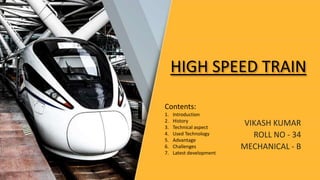
High Speed Train - seminar ppt
- 1. HIGH SPEED TRAIN VIKASH KUMAR ROLL NO - 34 MECHANICAL - B Contents: 1. Introduction 2. History 3. Technical aspect 4. Used Technology 5. Advantage 6. Challenges 7. Latest development
- 2. Introduction What is High Speed Train? • It is referred to as a type of rail that travels significantly faster than traditional rail traffic. • Trains running at a speed of more than 250 km/hr in new line and 200 km/hr in existing lines refered as a high speed train. • The first such system began operations in Japan in 1964 and was widely known as the bullet train. High speed rail programs have been successful in Japan, China and several European countries such as France, Germany and Spain.
- 3. HISTORY 1. 1899 - German Engineers sought a high speed train. 2. 1964 - Japan Capitalized on High Speed Train. 1. Shinkanse, that was also known as “bullet train” 2. Went 210km/h and carried 100millian people in fist 3 years 3. 1981 - High speed train revolution began in Europe starting with France 1. A diesel-powered railcar was modified with a gas-turbine, and was called "TGV". 2. It reached 230 km/h
- 4. TECHANICAL ASPECT • MAGLAV is the principle used in working of modern high speed train. • MAGLAV-derived from MAGnet and LEVitation. • Magnetic levitation transport is a form of transportation that suspend guides and propels vehicles through the harnessing of electromagnetic force. • A maglev train floats about 10mm above the guideway on a magnetic field.
- 5. MANGLEV TECHNOLOGY 1. There are two primary types of maglev technology: 1. Electromagnetic suspension (EMS) - The train levitates above a steel rail while electromagnets, attached to the train, are oriented toward the rail from below. 2. Electrodynamic suspension (EDS) - Both the rail and the train exert a magnetic field, and the train is levitated by the repulsive force between these magnetic field.
- 6. ADVANTAGES • Reduction of travel time of passengers. • Fast accessibility to urban centres, lead to economical and industrial growth. • Cope up higher demand for passenger and freight traffic. • High Speed Rail route will help in commercial growth. • Land required by the HSR(High Speed Rail) is very less, reducing environmental impact. • It is Energy Efficient mode with compared to other modes of transportation.
- 7. DIS-ADVANTAGES • Huge Investment- Financial Viability is major Issue. • Economical factors- Balance of income and out goings. • Technological factors like Technology for TracksTrains, Technology for Operation & geometrical changes required. • High Running and maintenance costs. • Safety consideration of Passengers as well as Surroundings. • High cost of journey will affect the affordability of Common man.
- 8. • In July 2014, a trial run of a “semi-high speed’’ with 10 coaches and 2 generators reached a speed of 160 km/h, between New Delhi and Agra. • As part of India’s two pronged strategy there is a focus on upgradation of existing railway system to semi high speed links parallely with bullet trains. • Indian Railways aims to increase the speed of passenger trains to 160–200 km/h on dedicated conventional tracks. High speed train in india
- 9. LATEST DEVELOPMENT 1. Today, the high-speed network in commercial operation is 52,418km- long, and 11,693km of high-speed lines are under construction around the world. 3. Vande Bharat Express is an Indian higher-speed rail unit, It has been designed and built under the Indian government's Make in India initiative. At the original price, it is estimated to be 40% cheaper than a similar train imported from Europe. It's max speed reach up to 180 km/h. 2. Recently, the super high-speed Virgin Hyperloop completed its first passenger ride at speeds of up to 172 km. It will run between pune and mumbai.
- 10. • International Union of Railways (UIC). • KIMT News. Associated Press. • AJW by The Asahi Shimbun. • Luxembourg: Publications Office of the European Union. • https://www.globalrailwayreview.com/article/112553/perpetual-growth-high-speed-rail/ REFERENCES Thank You